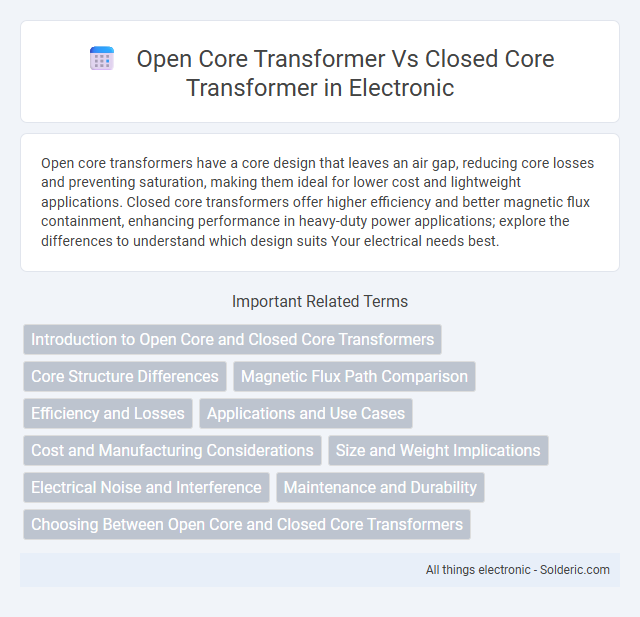Open core transformers have a core design that leaves an air gap, reducing core losses and preventing saturation, making them ideal for lower cost and lightweight applications. Closed core transformers offer higher efficiency and better magnetic flux containment, enhancing performance in heavy-duty power applications; explore the differences to understand which design suits Your electrical needs best.
Comparison Table
| Feature | Open Core Transformer | Closed Core Transformer |
|---|---|---|
| Core Structure | Core with gaps (E-I or C type) | Fully closed magnetic core (square or rectangular) |
| Magnetic Flux Path | Partially open, flux leaks through gaps | Continuous, minimal flux leakage |
| Efficiency | Lower due to flux leakage | Higher due to closed magnetic path |
| Size and Weight | Lighter and simpler design | Heavier due to more core material |
| Cost | Typically cheaper | Generally more expensive |
| Applications | Small power transformers, audio transformers | Power distribution, high voltage transformers |
| Mechanical Stability | Less stable due to open gaps | More stable and rigid |
| Noise Level | Higher noise due to vibration and flux leakage | Lower noise operation |
Introduction to Open Core and Closed Core Transformers
Open core transformers feature cores with intentional gaps or sections of air to reduce magnetic losses and prevent saturation, optimizing performance for variable load conditions. Closed core transformers use fully closed magnetic circuits with minimal gaps, providing efficient flux paths and typically delivering higher efficiency under steady-state operation. Designing transformers balances factors like core material, flux density, and loss mechanisms to suit specific industrial applications.
Core Structure Differences
Open core transformers have a core structure with gaps around which the coil is wound, allowing easier magnetic flux leakage but simpler construction and maintenance. Closed core transformers feature a continuous magnetic core that encloses the coil entirely, resulting in higher magnetic efficiency and reduced flux leakage. Your choice depends on balancing efficiency needs with design complexity in applications requiring magnetic flux control.
Magnetic Flux Path Comparison
The magnetic flux path in open core transformers is not fully enclosed, leading to higher leakage flux and lower magnetic efficiency compared to closed core transformers, where the flux path is continuous and completely enclosed within the core material. Closed core transformers use a laminated or solid magnetic core that provides a low-reluctance path for magnetic flux, minimizing energy losses and improving performance. The open core design typically results in increased electromagnetic interference (EMI) and reduced voltage regulation due to the dispersed magnetic field.
Efficiency and Losses
Open core transformers generally have higher core losses due to increased magnetic flux leakage and lower magnetic coupling efficiency, resulting in reduced overall efficiency compared to closed core transformers. Closed core transformers benefit from a continuous magnetic path that minimizes flux leakage and hysteresis losses, enhancing efficiency and reducing energy waste. Optimizing your choice between these types depends on balancing cost, efficiency, and application-specific requirements to minimize losses in your electrical system.
Applications and Use Cases
Open core transformers excel in applications requiring low noise and efficient heat dissipation, making them ideal for audio equipment, medical devices, and telecommunications. Closed core transformers are preferred in high-power industrial applications like power distribution, electric motors, and large-scale machinery due to their robust magnetic circuit and minimal leakage flux. Both types support specialized use cases based on performance, size constraints, and electromagnetic compatibility requirements.
Cost and Manufacturing Considerations
Open core transformers typically incur lower manufacturing costs due to simpler design and less material usage, resulting in cost-efficient mass production. Closed core transformers, while more complex and costly to manufacture, offer enhanced magnetic efficiency and reduced core losses, which can justify higher initial investment in applications demanding performance. Choosing between open and closed core transformers requires balancing cost constraints with desired efficiency and reliability in production.
Size and Weight Implications
Open core transformers generally have larger sizes and heavier weights due to their exposed magnetic core, which requires more insulation and structural support. Closed core transformers offer compact designs with reduced weight because their fully enclosed cores enhance magnetic flux efficiency and minimize losses. The difference in construction directly impacts the overall size and portability in applications such as power distribution and industrial use.
Electrical Noise and Interference
Open core transformers typically generate higher electrical noise and electromagnetic interference due to their less effective magnetic shielding, resulting in increased susceptibility to external disturbances. Closed core transformers are designed with a continuous magnetic path that minimizes leakage flux, significantly reducing electromagnetic interference and ensuring cleaner signal transmission. This makes closed core transformers more suitable for sensitive electronic applications requiring low noise levels.
Maintenance and Durability
Open core transformers typically require more frequent maintenance due to their exposure to environmental elements, which can lead to increased wear and potential corrosion. Closed core transformers offer enhanced durability by protecting the core and windings within a sealed enclosure, reducing the risk of contamination and mechanical damage. Your choice of transformer should consider the maintenance demands and longevity benefits associated with each core design.
Choosing Between Open Core and Closed Core Transformers
Choosing between open core and closed core transformers depends on your specific application requirements, especially regarding efficiency and magnetic flux containment. Closed core transformers offer superior magnetic coupling and reduced losses due to their continuous magnetic path, making them ideal for high-efficiency power supply designs. Open core transformers, while simpler and lighter, typically exhibit higher leakage flux and lower efficiency, suitable for less demanding or cost-sensitive applications.
open core transformer vs closed core transformer Infographic

 solderic.com
solderic.com